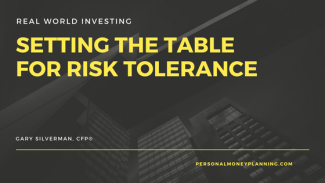
Setting the Table for Risk Tolerance
By Gary Silverman, CFP®
Last week we started to discuss investment risk and how to manage that risk. In my practice we use a test developed by FinaMetrica for our clients. (Last I checked they’ll let you take it for $45 at www.MyRiskTolerance.com.) I’ve found it quite effective. In fact it was the only risk measurement device that could correctly predict how both my wife and I react to different market conditions.
The problem is that this type of measure only tells us a portion of how you and risk get along. That’s because there is more to risk tolerance than your emotional ability to handle risk. So let’s take some time and discuss three aspects to risk tolerance that will give you a better picture of it.
The first attribute of risk tolerance is Capacity. This is your ability to sustain a market decline without it causing you to reduce your standard of living now or in the future. This isn’t a rich vs. poor determination, but rather an income vs. expenses one. For example, if your portfolio can reasonably produce double the income you need to live on, then you could sustain very large fluctuations in value without it affecting your lifestyle at all. You could also take less risk than your risk attitude (below) would allow since you don’t need the extra return it provides.
Capacity is the situation you bring to the table.
The next attribute is Perception. If you know that stocks often can drop 20% and sometimes drop 50% in a single year, you will not be surprised and scared off when that actually happens. You know that stocks eventually go back up and that if you hang around long enough, things not only even out, but you make money. You also know that bonds, real estate, and commodities also bounce around. If you knew your bond portfolio could drop 15% (more if you were in higher risk “junk” bonds) and it did, you, again, wouldn’t be surprised. On the other hand, if you thought bonds were equivalent to cash in that they never go down in value, you’d be shocked when they dropped.
Perception is the knowledge you bring to the table.
The last attribute of risk tolerance is Attitude. This is what we learn from the FinaMetrica survey, along with getting to know our clients as people. Attitude is your psychological inclination to take a level of risk in exchange for a potential reward. Regardless of how much money they have and how much knowledge they have, some folks can’t stand the bouncing around of the markets. Others are perfectly calm with the market swings.
Attitude is the emotion you bring to the table.
Now, your risk tolerance table is set.
Next week we’ll start eating!
This article was published in the Wichita Falls Times Record News on March 26, 2017.
Gary Silverman, CFP® is the founder of Personal Money Planning, LLC, a Wichita Falls retirement planning and investment management firm and author of Real World Investing.

